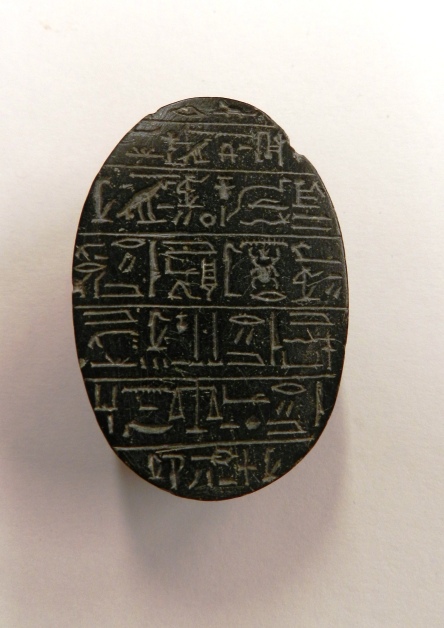Visitors sometimes comment that they would like to have access to translations of the hieroglyphic texts that appear on some of our Egyptian and Sudanese objects. We aim to provide these as a digital resource to complement the new Ancient Worlds galleries, and I will post them here as time – and work – allows. On a recent visit to the Museum, a group called Forever Young expressed a particular liking for this text, so it seemed a good place to start.
This spell is of a type usually carved on the underside of amulets known as Heart Scarabs. This example dates to the later New Kingdom (c. 1320-1069 BC), and belonged to a scribe named Na-her-hu. This is a shortened version of Spell (or ‘Chapter’) 30B of the Book of the Dead: slightly different versions are sometimes included in papyrus copies of the Book.
‘The Osiris, Scribe of the Mat, Na-her-hu, justified, he says: “O my heart, which I had from my mother, the centre of my being. Do not stand against me as a witness, do not oppose me in the judgement hall, in the presence of the keeper of the balance. You are my ka (spirit) in my body, the creator [who makes my limbs prosper]”.’
The Egyptians believed that in order to gain entry into the Afterlife – described as a blissful ‘Field of Reeds’ – one had to undergo judgement before the gods. During mummification, all the internal organs were removed – except the heart, which was regarded as the seat of intelligence and emotion. The righteousness of the deceased was assessed by weighing the heart on a set of scales. If it balanced with a feather, a symbol for truth, then the deceased was declared ‘justified’ and could enter the afterlife. If, however, the heart was heavier than the feather – presumably weighty with wickedness – then it was swallowed by a monster called Ammut (‘the Devourer’): part crocodile, part lion, part hippo. This was the second death that all Egyptians feared, and meant non-existence.

Thoth, 'keeper of the balance', leads Asru before the gods. From the judgement scene of her inner coffin (c. 700 BC).
https://egyptmanchester.wordpress.com/2012/02/06/texts-in-translation-1-the-heart-scarab-of-na-her-hu-acc-no-5998/


No hay comentarios:
Publicar un comentario